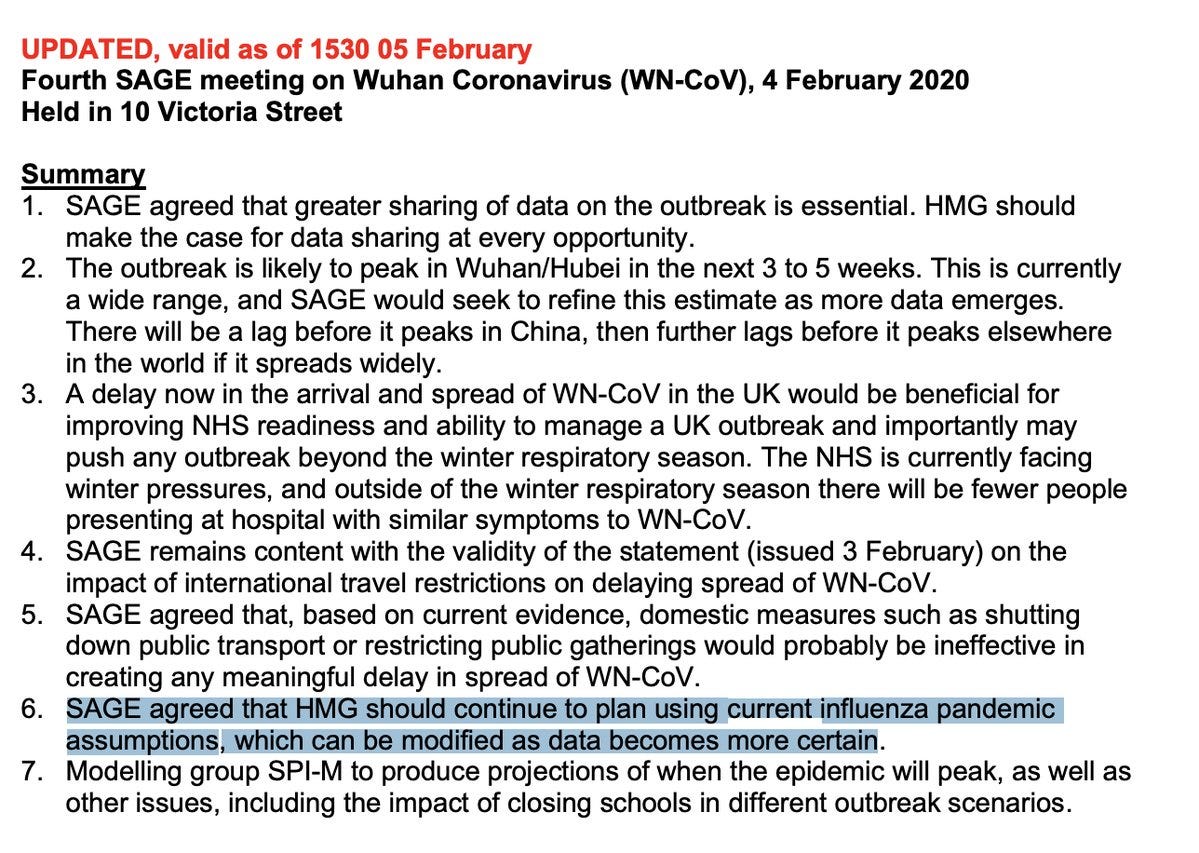It’s bizarre that this needs saying, but *of course* the UK had a Herd Immunity plan
What it was, where it came from, and how it was abandoned
I waited an extra day to release this post, in case there was anything new in Dominic Cummings’ evidence to the Select Committee. I added a couple of bits but it’s sort of the point of this project that nearly all his “shocking revelations” were public prior to his evidence. It’s still very much worth a watch
The UK Herd Immunity Plan
It’s bizarre that this needs saying, but the UK had a herd immunity plan. That is to say, an official plan to manage the mass infection of the population until we reached herd immunity. It was outlined in official government documents and described in media appearances by our top scientists, who mostly went on to pretend it never happened.




So how did this happen? Prior to the pandemic, the UK’s standing assumptions and planning for new infectious disease threats were built around the idea that a new virus would not be possible to keep out of the country, or to control or eliminate once in the country.
If you can’t keep it out or stop it, it’s inevitable that it will keep infecting people either until you get a vaccine or you reach the point at which a sufficiently large proportion of the population have become infected and therefore immune- “herd immunity”.
Once the pandemic hit, UK science advisors and government decision-makers applied this conventional wisdom to covid.
On the 4th of February, at the UK Scientific Advisory Group for Emergencies’s fourth Covid meeting, influenza planning, with its assertions that spread was “inevitable”and halting the virus “a waste of resources” was adopted as the official recommendation- tragically this was about ten days before Chinese covid cases peaked, never return to their early 2020 levels.
All the way through the various SAGE minutes you can see only references to “slowing” the spread of the disease or “delaying” its peak- never stopping or eliminating it.
The scientific consensus presented to ministers was: mass infection of the population was inevitable, a vaccine would not be available in time, so the only choices were about how to manage the mass infection of the population until the country had accumulated enough cases to get to herd immunity.
Managing the mass infection of the population became known as the “herd immunity plan”; though in reality there were lots of different plans and ideas, which all took the belief in inevitable mass infection as axiomatic. Eventually they coalesced into what became known internally as the “Single Peak” strategy: to allow infections to grow through the summer, slow down but not stop them with distancing measures, increase hospital capacity to care for some of the sick, and try to keep the elderly and most likely to die out of the way. The end result would be a country in which the majority were infected and recovered and the virus would be unable to find susceptible people to catch it: herd immunity by September 2020, 259,000 extra deaths, peaking at 5000 per day in June.
The alternative being attempted by governments elsewhere, trying to stop the disease from infecting the population, was regarded as folly; the UK government’s scientific advisors were certain that countries attempting suppression would fail
The single peak or herd immunity strategy (the blue line) would have led to NHS capacity (the red line just above the x axis below) being exceeded many times over
The public and much of the media had been operating under the assumption that the UK government would try to keep the virus from infecting people, not to allow it to “pass through” the population. On March 13th 2020, it was revealed that this was not the case in an explosive blogpost written by Robert Peston.


Peston’s post, written after a high-level briefing on theUK pandemic plan and coupled with explanatory statements from senior science and health advisors, triggered a popular backlash


Partly in response to this outrage, the government changed course; Boris Johnson swapped strategies and began locking down the country just 3 days after the herd immunity plan became public, with new priorities built around suppressing the virus with blunt instruments such as lockdowns to buy time for building countermeasures- testing and tracing capacity, vaccines, treatments.
The reception to the original mass infection plan was so extreme that various people involved in it have tried very hard to pretend it never happened, which I’ll go over in next week’s post. For now, do consider switching to a paid sub- you’ll get exclusive posts and help support the archive digging which keeps this project going









